Manufacturing Success Despite a Difficult Economic Environment
This year's mantra among rapid technology companies: go after manufacturing.
Latest News
August 30, 2009
By Susan Smith
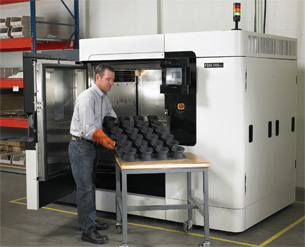 An engineer removes parts from the Stratasys Fortus 900mc machine, which was designed for direct digital manufacturing (DDM). Image courtesy of Stratasys |
Nowadays, a primary topic of conversation is how we are all surviving these difficult times. Yet despite the economic doldrums affecting everyone, some companies in the rapid technology sector are maintaining successful operations. Desktop Engineering asked a handful of them how they’ve weathered the downturn.
A number of factors are in the mix: Traditional markets such as aerospace, and medical and dental are still doing well; rapid prototyping (RP) companies are transitioning from building concept models to manufacturing final products; services bureaus are more popular and numerous; and the tools that help users streamline processes, saving time and money, are hot.
Moving RP into Manufacturing
“Go after manufacturing” is this year’s mantra among RP companies.
Shane Glenn, Stratasys’ director of investor relations, said that, in spite of the global economy’s generally negative impact, they are experiencing a trend toward rapid manufacturing with their high-end Fortus line.
“We are a traditional equipment manufacturer with technology that’s not necessarily new, but which offers great value to the end user,” said Glenn. “End users that have historically used our technology in the design and engineering phase of new product development are taking that technology and incorporating it into latter stages of manufacturing occasionally and using the technology for the manufacture of end-use parts.”
Both Stratasys’ low-end and high-end additive fabrication systems are based on fused deposition modeling (FDM) technology and use a similar operating process. Stratasys refers to their large systems (Fortus) as 3D production systems and the smaller, lower priced systems as 3D printers (Dimension and uPrint).
Glenn said, “flat is the new growth, … it’s all relative, we’re living in an environment none of us today has ever experienced. It’s unprecedented what is happening globally and in financial markets and manufacturing. Stratasys is doing well … compared to what’s going on in the overall economy.”
In Q4 of 2008, according to Glenn, maintenance contracts (and thus revenue) increased, driven by an increase in the installed system base.
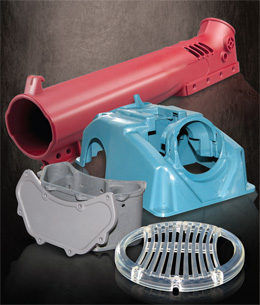 Quickparts, which offers online quoting, can handle a host of materials. Image courtesy of Quickparts |
Dimension targets customers for whom 3D printing is relatively new and whose focus is concept models and prototypes. In this economy, they are reluctant to make those purchases, according to Glenn. A few years ago, low-end 3D printing was the faster growing part of Stratasys’ business.
Strategically, Stratasys has made a significant shift from a distribution model that is direct to one that is indirect with distributors for the Fortus brand.
“We’ve made significant changes just on the high end in the past six to twelve months…,” explained Glenn. “At the low end side … we’ve also made some big changes (providing a better product that is affordable) with our most recent product, uPrint. At the other end, we will continue developing new applications to go after manufacturing.”
Recently Stratasys wrapped the uPrint and Dimension business groups back together rather than operating them separately—coinciding with the aforementioned distribution model. The uPrint is small enough to actually fit on a desktop, and is very easy to use.
EOS North America, a fully owned subsidiary of EOS GmBH, is an OEM selling and supporting German-manufactured EOS machines from offices in Oregon.
North American VP Jim Fendrick said, “I haven’t seen any waning in interest in our product. There are many needs in industry, but there has been a dramatic drop-off of the financial means to obtain them. It’s hard to go to the board of directors and ask for half-a-million dollars to save the company money just after laying off 2,000 people. That’s the big change I’ve seen.”
While the economy is currently keeping the company from hiring people it might otherwise have hired, it will not lay anyone off.
Fendrick said privately owned EOS North America began its fiscal year in October at about 5-6% ahead of last year, down from their typical 30-40%, “but not a negative effect yet,” he said.
Industries the company has served include medical, aerospace and “other,” which include service bureaus, manufacturers of non-medical or aerospace parts. “Medical is still going strong, aerospace is going somewhat, and ‘other’ has disappeared but been replaced by more medical,” reported Fendrick.
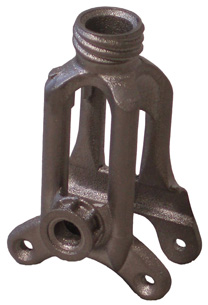 A titanium motorcycle brake mount manufactured in a direct-to-metal laser sintering machine from EOS. Image courtesy of EOS |
One positive is the medical industry’s discovery that there are many new applications for EOS equipment. Some dental labs have replaced the casting process for copings and crowns by sintering with EOS equipment, enabling more accurate, faster, cheaper copings and crowns. In the medical field, there are numerous projects for instrumentation using customized instruments for implants.
EOS recently announced that Morris Technologies, Inc. purchased an EOSINT M 270 system to laser-sinter titanium, the company’s ninth direct-to-metal laser sintering machine acquired from EOS. Morris Technologies spokesman Greg Morris says yearly demand for laser-sintering services has increased, and it expects a great demand for titanium parts. The new system will be used to offer rapid prototyping and manufacturing in titanium to aerospace and medical industry customers.
Materials and Tracking
Manufacturing processes are being developed to certify materials, know their origins, provide batch numbers, and certify material temperatures during sintering. Each layer might have a different parameter requiring certification. “All that information must be tracked,” Fendrick said. “We have to develop equipment to measure temperatures in different areas of the building document, and these processes requiring modifications to our equipment are being worked on today.”
Fendrick said that both software and hardware are affected by these changes. If a new type of material is derived that requires a more powerful laser that the company would need to develop, it would also require a hardware modification to capture information with sensors.
“There’s a lot of new interest, and applications being discovered for it,” said Fendrick. “I’m not worried about survival.… Watch costs, support customers, supply good product; you’ll be OK.”
Rapid Services
Rapid prototyping services have proliferated in recent years, in some cases offering 24-hour turnarounds. These service bureaus are doing well and growing to meet the increasing demand for custom and mass-produced parts.
Quickparts makes it easy for customers to buy, offering good prices and helpful staff. “We do the same thing as Home Depot, but we do it with custom parts for engineers who are developing their product,” explained Patrick Hunter, president of sales and marketing.
Hunter described the company as a “virtual manufacturer” for custom parts. “Our business model leverages the excess capacity in the market so that we can provide the best price and service to our customers for their low-volume custom parts needs,” he said. “We don’t have equipment, don’t do manufacturing ourselves—we serve the customer with high-end sales service and high-end project management service and we partner with best-of-breed markets and attract relationships with Quickparts to produce our orders on demand.”
Quickparts, which provides online quoting for custom parts and provides low-volume injection molded parts out of engineered plastic in a matter of days, is focused on reaching $1 million in revenue. Hunter said that Quickparts will not lay anyone off; in fact, it’s looking for great people.
Tools for Streamlining Work Processes
Another company citing medical as one of its primary industries is privately owned Materialise. Colleen Wivell, general manager for the U.S., said that Materialise addresses diverse markets: medical device, automotive, aerospace, consumer goods, and universities. That diversification, said Wivell, makes the company more resilient.
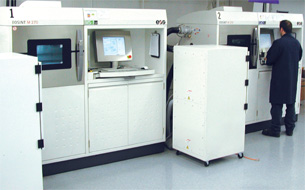 Morris Technologies has several EOS M 270 systems, which enable the company to produce rapid titanium parts for aerospace and medical customers. Image courtesy of Morris Technologies |
In the U.S., Materialise provides sales, technical support, training, and marketing for the company’s software products. Like other RP firms, Materialise in the U.S. has experienced delays in hiring new people. And, like other RP firms, Materialise finds that the medical implant business is less affected by the recession in general.
“Yes,” said Wivell, “budgets have been slimmed down because of the economy and some people have been concerned about what this new healthcare system will mean to the healthcare industry. But the medical device industry is still going strong.”
Tools that will help customers streamline their processes for more efficiency are increasingly valuable. Materialise is focusing its attention on its technical line of products.
A case in point is E-Stage, an automatic support generator, a software product that can run as a standalone and can generate reports automatically. “It’s very accurate, and when you build a part that’s been set up with automatic supports, it uses less material, they’re easier to remove and the parts are easier to finish,” said Wivell. The product primarily focuses on support generation for stereolithography.
The company’s Magics product enables designers to save materials. Services bureaus may use Magics to check every part for feasibility before building it.
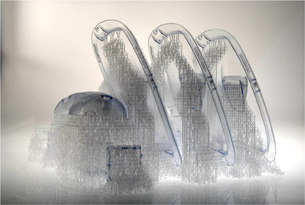 Materialise is focusing its attention on its technical line of products. A case in point is E-Stage, an automatic support generator. Image courtesy Materialise |
One product from Materialise focused on SLS technology, SmartSpace, automatically does 3D nesting based on a part’s geometry. “Packing that build platform tighter and building more parts will save time and money,” said Wivell.
Although we may see some consolidation in the market, the drive currently is to find cheaper ways of getting products manufactured, and customers finding new applications for existing technologies. Through partnerships with customers, RP companies will discover new material and product needs destined to fuel growth for the future.
More Info:
Stratasys
Electro-Optical Systems (EOS) NorthAmerica
Contributing editor Susan Smith has been working as an editor and writer in the technology industry for more than 16 years. Send e-mail about this article to [email protected].
Subscribe to our FREE magazine, FREE email newsletters or both!
Latest News
About the Author
DE’s editors contribute news and new product announcements to Digital Engineering.
Press releases may be sent to them via [email protected].






